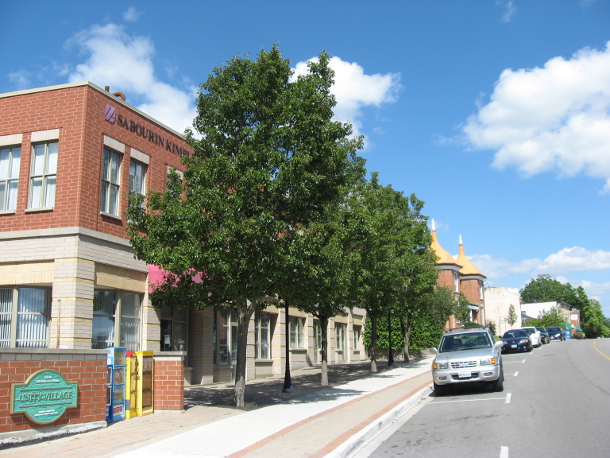Silva Cells were originally developed to provide adequate tree rooting volumes even in areas dominated by pavement. They do this by extending rootable soil volume under HS20 load bearing surfaces. These rootable tree volumes and the large trees that root in them are also an efficient sustainable stormwater management system. Sometimes people ask us if Silva Cells can be used without plants to treat stormwater, so today I want to talk about the ways in which plants contribute to the stormwater benefits of soil bioretention systems.
Interception and Evapotranspiration
Two stormwater treatment mechanisms that are absent when plants are not used in the system are interception and evapotranspiration. Water that is intercepted or evapotranspired by plants is abstracted – meaning neither this water, nor any pollutants in it, will leave the site via stormwater pipes.
Woody vegetation typically intercepts and evapotranspires significantly more water than herbaceous vegetation, and large trees intercept and evapotranspire significantly more rain than small trees. For example, a healthy 40 year old Hackberry tree in the Midwest is estimated to provide 14 times as much interception as a 10 year old Hackberry (McPherson et al 2006). To read more about interception and evapotranspiration, see “Stormwater Quantity and Rate Control Benefits of Trees in Uncompacted Soil”.
Long Term Infiltration
As plant roots grow and then decay, they leave open channels in the soil that restore and/or enhance soil porosity and infiltration rates. Several studies that have compared bioretention treatments with plants to barren bioretention treatments have found a significant increase in saturated hydraulic conductivity with plants vs. without plants (e.g. Lucas and Greenway 2011). Plant roots have even been shown to be able to penetrate confining layers, such as, for example, a layer of clay soil or compacted soil (Selbig and Balster 2010, Bartens et al 2008). Without plants, these confining layers would significantly slow down infiltration rates. Bartens et al (2008), for example, found that tree roots were able to penetrate through a geotextile and underlying compacted clay loam subsoil, increasing the average infiltration rate 27-fold compared to unplanted controls.
Water Quality Benefits
Studies have also found that vegetation is crucial to many water quality benefits, including removal of dissolved nutrients, hydrocarbons, and TSS:
- Dissolved nutrient removal
Studies that have compared bioretention systems without plants to bioretention systems with plants have found that plants significantly improve dissolved nutrient removal (nitrogen and phosphorus) (Henderson 2009, Lucas and Greenway 2008, Lucas and Greenway 2011, Denman 2006, Barret et al 2013). While unplanted bioretention systems often actually contribute nutrients rather than remove them, planted bioretention systems can provide significant (up to 99% PO4-P retention) dissolved nutrient removal (Lucas and Greenway 2011). Moreover, the healthier and more vigorous the vegetation is, the greater the removal of dissolved nutrients (Henderson 2009, Read et al 2010).
See our previous three part series of blogs on plants and nutrient removal (Part I, Part II, Part III) for much more detail on this topic.
- Hydrocarbon removal
Planted soil has also been shown to provide higher hydrocarbon removal rates than vegetated soil (Lefevre et al 2012a, Lefevre et al 2012b, Aprill and Sims 1990). Plants take up hydrocarbons and also stimulate the growth of hydrocarbon degrading bacteria in the rhizosphere (e.g. Lefevre 2012b). Deep rooted natives or cultivars can provide for increased biodegradation performance compared to shallow rooted turf grass or unplanted systems (Lefevre 2012a).
- TSS sequestration
Plants also slow water flow, which allows more time for sedimentation to occur (Hunt et al 2012).
So, there is lots of scientific evidence supporting the important role that trees play in the effectiveness of sustainable bioretention systems. In addition to that, of course, trees also add essential life and beauty into urban areas!
Nathalie Shanstrom is a Lansdcape Architect with the Kestrel Design Group. She specializes in sustainable design.
References:
Aprill, W. and Sims, Ronald C., “Evaluation of the Use of Prairie Grasses for Stimulating Polycyclic Aromatic Hydrocarbon Treatment in Soil” (1990). Biological Engineering Faculty Publications. Paper 41.
Barrett, M.E., Limouzin, M., and Lawler, D.F. (2013). “Effects of media and plant selection on biofiltration performance.” Journal of Environmental Engineering. In press.
Bartens, J.; Day, S. D.; Harris, J. R.; Dove, J. E.; Wynn, T. M. 2008.Can Urban Tree Roots Improve Infiltration through Compacted Subsoils for Stormwater Management? Journal of Environmental Quality, 37, 2048–2057.
Denman, L., P. May, and P. Breen. 2006. An investigation of the potential to use street trees and their root zone soils to remove nitrogen from urban storm water. Australian Journal of Water Resources 1(3): 303-311.
Henderson, C.F.K. 2009. The Chemical and Biological Mechanisms of Nutrient Removal from Stormwater in Bioretention Systems. Thesis. Griffith School of Engineering, Griffith University.
Hunt, W., Davis, A., and Traver, R. 2012. Meeting Hydrologic and Water Quality Goals through Targeted Bioretention Design. J. Environ. Eng., 138(6), 698–707.
doi: 10.1061/(ASCE)`EE.1943-7870.0000504
LeFevre, G.H., M. Raymond, P. Hozalski, J. Novak. 2012a. The role of biodegradation in limiting the accumulation of petroleum hydrocarbons in raingarden soils. Water Research 46: 6753-6762.
Lefevre, G.H., P.J. Novak, R.M. Hozalski. 2012b. Fate of naphthalene in laboratory-scale bioretention cells: implications for sustainable stormwater management. Environmental Science and Technology 46(2):995-1002.
Lucas, W. C. and M. Greenway. 2011. Hydraulic Response and Nitrogen Retention in Bioretention Mesocosms with Regulated Outlets: Part I—Hydraulic Response. Water Environment Research 83(8): 692-702.
McPherson, E. G., J.R. Simpson, P.J. Peper, S.E. Maco, S.L. Gardner, S.K. Cozad, Q. Xiao. 2006. Midwest Community Tree Guide: Benefits, Costs and Strategic Planting PSW-GTR-199. USDA Forest Service, Pacific Southwest Research Station, Albany, CA.
Read, J., Fletcher, T.D., Wevill, T., and Deletic., A. (2010). “Plant traits that enhance pollutant removal from stormwater in biofiltration systems.” International Journal of Phytoremediation. 12(1), 34-53.
Selbig, W.R., and N. Balster. 2010. Evaluation of turf-grass and prairie-vegetated rain gardens in a clay and sand soil: Madison, Wisconsin, water years 2004–08: U.S. Geological Survey, Scientific Investigations Report 2010–5077, 75 p.
Top image Flick credit: Betta






Leave Your Comment